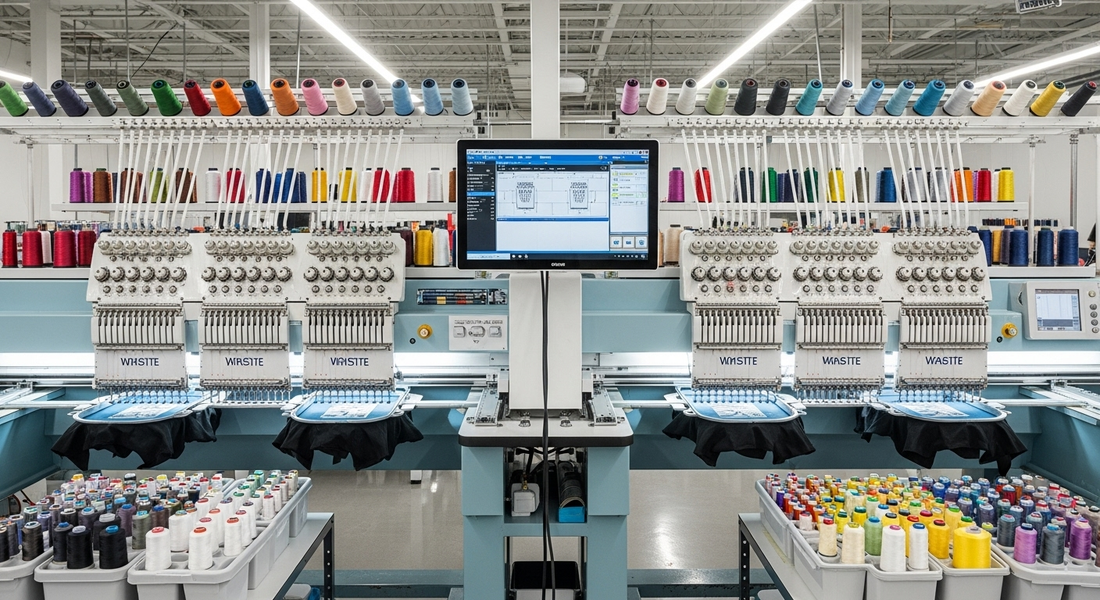
How to Actually Speed Up Production (Without Everything Looking Like Garbage)
Share
Okay, real talk - when you're trying to make money with embroidery, you need to move fast. But you also can't have stuff looking like it came from a sketchy roadside stand. I've been there, trying to rush through orders and ending up with thread breaks, wonky tension, and customers who aren't happy.
Here's what actually works for speeding things up without your quality going down the drain.

Multi-Needle Machines - Just Do It Already
If you're still doing color changes by hand on every single design, you're basically throwing money away. I spent way too long thinking I couldn't justify the cost of a multi-needle machine.
The math is simple: a 6-color logo that takes me 45 minutes with thread changes now takes 15 minutes straight through. That's three times as many shirts per hour. The machine pays for itself pretty quickly when you look at it that way.
Bobbin Prep - Boring But Essential
I learned this the hard way after sitting around for 10 minutes waiting for a bobbin to wind in the middle of a rush order. Now I wind a dozen bobbins every Sunday night while watching TV.
Get a separate bobbin winder if you can. Wind them while your machine is running other stuff. Never be caught without wound bobbins again.
Hooping - Set Up Your Assembly Line
This is where most people waste time without realizing it. Set up multiple hooping stations if you have the space. While one item is stitching, you're prepping the next three.
Those alignment grids and templates aren't just for beginners - they're for speed. I can center a logo in about 10 seconds now instead of eyeballing it and hoping for the best.
Magnetic hoops are worth every penny too. Your hands don't get tired, and hooping is just faster.

Group Everything - Stop Switching Around
This seems obvious but you'd be surprised how many people don't do it. Run all your navy shirts together, then all your red ones. Do all the left chest logos, then all the back pieces.
Every time you change thread colors or move to a different design, you're losing time. Batch everything you can.
Multiple Machines - If You Can Swing It
Two machines running different jobs can double your output without doubling your work. I run caps on one machine and shirts on another. Different thread colors, different designs, no conflicts.
You don't need to buy two identical machines either. A single-needle for simple stuff and a multi-needle for complex designs works great.
Get Your Files Organized
I used to waste so much time looking for files. Now everything has a system:
- Client name, item type, design name
- All tested and approved designs in one master folder
- Machine settings saved with each design
Sounds nerdy, but when you're rushing to fill an order, you'll appreciate being able to find everything instantly.
Prevent Problems Before They Happen
Nothing kills speed like a broken needle or thread nest in the middle of a big order. I clean my machine every morning and check tension weekly.
Quality thread and stabilizers cost a bit more but save you from constantly dealing with breaks and re-dos. Cheap thread is expensive when you factor in the time you lose.
Advanced Stuff - If You're Really Serious
Some of the commercial setups use barcode systems where you scan a code and the machine automatically loads the right design and settings. Pretty cool if you're running a bigger operation with multiple people.
Smart Scheduling
Group similar jobs together. All the caps on Tuesday, all the jackets on Wednesday. Your machine stays set up for similar items, and you're not constantly adjusting hoops and settings.
Monograms are perfect for batching by thread color. Do all the navy letters, then all the red ones.
What Actually Matters
Here's the thing - speed comes from eliminating the little time-wasters, not from running your machine faster. You can crank up the speed, but you'll just get more thread breaks and tension issues.
Focus on reducing setup time, preventing problems, and keeping your workflow smooth. The actual stitching time is usually the smallest part of any job.
Reality Check
I probably doubled my daily output just by getting organized and investing in the right equipment. Most of it wasn't even expensive stuff - just thinking through the process and eliminating the stupid time-wasters.
Start with organization and bobbin prep. Those are free and will make an immediate difference. Then work on the equipment upgrades as you can afford them.
The goal isn't to rush through everything - it's to spend your time on the stuff that actually matters instead of fumbling around looking for files or waiting for bobbins to wind.